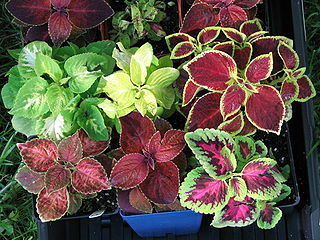
Solenostemon, commonly known as Coleus is a genus of flowering plants in the family Lamiaceae. Several species formerly included have been moved to the genus Plectranthus. They are native to tropical Africa, Asia and Australia. Some species are cultivated for their highly variegated leaves.

The Endangered Species Act of 1973 serves as the enacting legislation to carry out the provisions outlined in The Convention on International Trade in Endangered Species of Wild Fauna and Flora (CITES). Designed to protect critically imperiled species from extinction as a "consequence of economic growth and development untempered by adequate concern and conservation", the ESA was signed into law by President Richard Nixon on December 28, 1973. The law requires federal agencies to consult with the Fish and Wildlife Service &/or the NOAA Fisheries Service to ensure their actions are not likely to jeopardize the continued existence of any listed species or result in the destruction or adverse modification of designated critical habitat of such species. The U.S. Supreme Court found that "the plain intent of Congress in enacting" the ESA "was to halt and reverse the trend toward species extinction, whatever the cost." The Act is administered by two federal agencies, the United States Fish and Wildlife Service (FWS) and the National Marine Fisheries Service (NMFS).
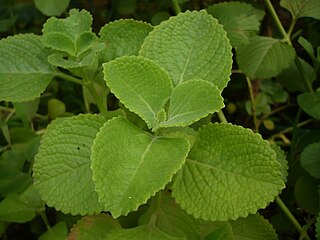
Plectranthus amboinicus, once identified as Coleus amboinicus, is a semi-succulent perennial plant in the family Lamiaceae with a pungent oregano-like flavor and odor. It is native to Southern and Eastern Africa. It is widely cultivated and naturalized elsewhere in the tropics where it is used as a traditional medicine, spice, and ornamental plant.

The conservation status of a group of organisms indicates whether the group still exists and how likely the group is to become extinct in the near future. Many factors are taken into account when assessing conservation status: not simply the number of individuals remaining, but the overall increase or decrease in the population over time, breeding success rates, and known threats. Various systems of conservation status exist and are in use at international, multi-country, national and local levels as well as for consumer use.

Plectranthus rotundifolius or Solenostemon rotundifolius, commonly known as native or country potato in Africa and called Chinese potato in India is a perennial herbaceous plant of the mint family (Lamiaceae) native to tropical Africa. It is cultivated for its edible tubers primarily in West Africa, as well as more recently in parts of Asia, especially India, Sri Lanka, Malaysia, and Indonesia.

Plectranthus, with some 350 species, is a genus of warm-climate plants occurring largely in the Southern Hemisphere, in sub-Saharan Africa, Madagascar, India and the Indonesian archipelago down to Australia and some Pacific Islands. They are closely related to Solenostemon and are known as the spurflowers. Several species are grown as ornamental plants, as leaf vegetables, as root vegetables for their edible tubers, or as medicine.
Plectranthus esculentus, with English common names kaffir potato, and Livingstone potato, is a species of plant in the dicot family Lamiaceae. It is indigenous to Africa, where it is grown for its edible tubers. It is more difficult to cultivate than Plectranthus rotundifolius, but able to give greater yields. Although the crop is similar to a potato it is from the mint family but it is still quite nutritious and useful. This crop can benefit many subsistence farmers since it is native, easy to grow, growing popularity in the market and quite nutritious.
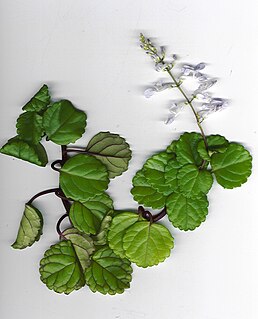
Plectranthus verticillatus, Swedish ivy, Swedish begonia or whorled plectranthus) is a plant in the family Lamiaceae (Labiatae), genus Plectranthus.

A near-threatened species is a species which has been categorized as "Near Threatened" (NT) by the International Union for Conservation of Nature as that may be considered threatened with extinction in the near future, although it does not currently qualify for the threatened status. The IUCN notes the importance of re-evaluating near-threatened taxon at appropriate intervals.
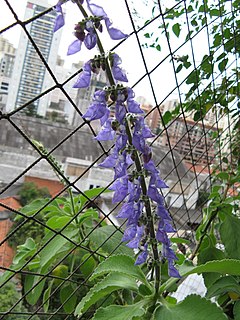
Plectranthus barbatus, also known by the synonym Coleus forskohlii and vernacular names forskohlii and Indian coleus, is a tropical perennial plant related to the typical coleus species. It produces forskolin, an extract useful for pharmaceutical preparations and research in cell biology.

Plectranthus scutellarioides, commonly known as coleus, is a species of flowering plant in the family Lamiaceae, native to southeast Asia through to Australia. Typically growing to 60–75 cm (24–30 in) tall and wide, it is a bushy, woody-based evergreen perennial, widely grown for the highly decorative variegated leaves found in cultivated varieties. Another common name is painted nettle, reflecting its relationship to deadnettles, which are in the same family. The synonyms Coleus blumei and Solenostemon scutellarioides are also widely used names for this species.
Plectranthus cataractarum is a species of flowering plant in the family Lamiaceae. It is found in Cameroon and Equatorial Guinea. Its natural habitats are subtropical or tropical moist lowland forests and rivers, near waterfalls. It is threatened by habitat loss.
Plectranthus socotranus is a species of flowering plant in the family Lamiaceae.
Plectranthus unguentarius is a species of flowering plant in the family Lamiaceae. It is found only in Namibia. Its natural habitat is rocky areas. It is threatened by habitat loss.
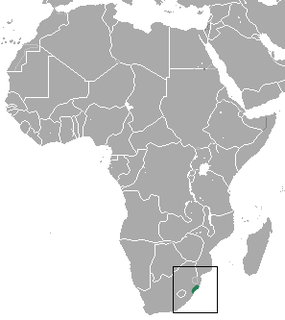
Sclater's mouse shrew is a species of mammal in the family Soricidae endemic to South Africa. Its natural habitats are subtropical or tropical moist lowland forests and swamps. It is threatened by habitat loss.

The Day's shrew is a species of mammal in the family Soricidae. It is endemic to India. Its natural habitat is subtropical or tropical dry forests. It is threatened by habitat loss.

Plectranthus parviflorus, known as little spurflower or cockspur flower, is a shrub, occurring in Hawaii, Polynesia and Australia. Non aromatic, between 10 and 70 cm high. The habitat is shady moist areas, including eucalyptus forest and rainforest. A widespread species, in rocky areas and beside streams. Attractive blue and white flowers may occur throughout the year.

A vulnerable species is one which has been categorized by the International Union for Conservation of Nature as likely to become endangered unless the circumstances that are threatening its survival and reproduction improve.
Precis rauana, the montane commodore, is a butterfly in the family Nymphalidae. It is found in Nigeria, from Cameroon to the Democratic Republic of the Congo and in Uganda, Kenya, Tanzania and Zambia. The habitat consists of forests.
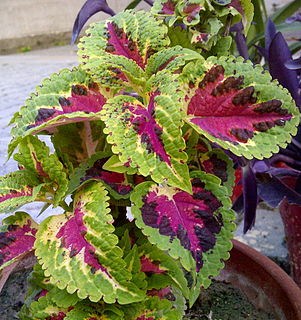
Coleus is a former genus of flowering plants in the family Lamiaceae. In recent classifications, the genus is no longer recognized, and the formerly included species are instead placed in the genera Plectranthus and Solenostemon. Because the type species, Coleus amboinicus is now placed in Plectranthus, Coleus is regarded as a synonym of Plectranthus. The term "coleus" is often used as a common name for species formerly placed in the genus Coleus that are cultivated as ornamental plants, particularly Coleus blumei, which is popular as a garden plant for its brightly colored foliage. This plant prefers bright, but indirect sunlight. If direct sunlight touches the plants leaves the colors become less brightly colored. Outside this plant needs total shade or only the most mild morning sunlight. A greenhouse environment is a good choice for Coleus blumei.
















